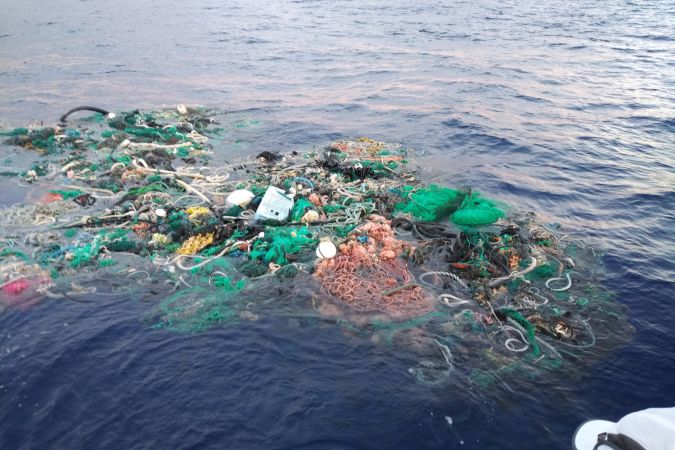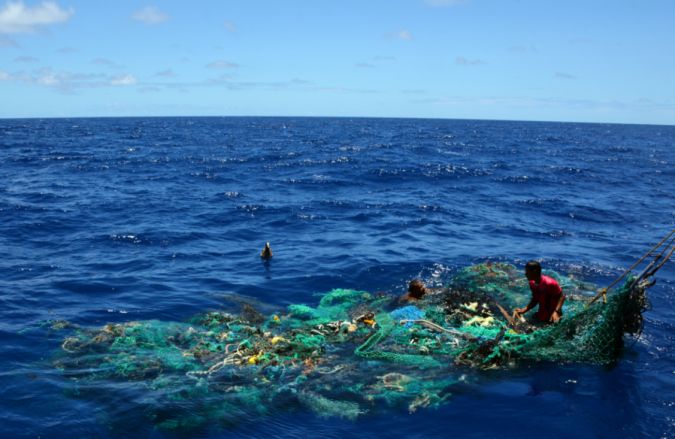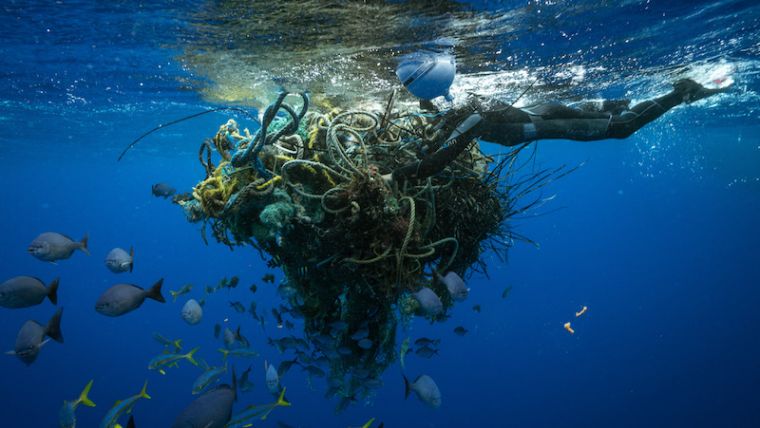How GPS trackers and drones help locate floating debris
An estimated 600,000 tons of abandoned fishing gear ends up in the oceans every year. According to the United Nations, some 380,000 marine mammals are killed each year, either by ingesting this fishing gear or being caught in it. Mary T. Crowly of the Ocean Voyages Institute describes how GPS trackers are being used to mark the ghost nets.
The Ocean Voyages Institute is a non-profit organization based in Sausalito, California (US). It leads the way in utilizing and adapting existing maritime equipment with innovative approaches to ocean clean-up. For the past 40 years, the Ocean Voyages Institute has devoted its efforts to ocean conservation and preservation and worked in conjunction with global sail-training education and the international maritime industry. As it works internationally, it is well-positioned to continue cleaning the North Pacific Gyre (considered the most polluted gyre) as well as areas such as Indonesia, the Mediterranean and Polynesia.
The first research expedition and clean-up mission was conducted in 2009 on the 151' Brigantine Kaisei working in tandem with the Scripps Institute of Oceanography R/V New Horizon. Since 2009, the Ocean Voyages Institute has continued research on the North Pacific Subtropical Convergence Zone and carried out testing of clean-up methods and additional expeditions.
Marine debris collection think tank
Formed in 2010 by William Hurley, former President of Seattle-based Glosten Associates and Mary T. Crowley of the Ocean Voyages Institute, this collection of naval architects, marine engineers, oceanographers, marine biologists, fishermen and maritime industry professionals from around the world focused on analysing the problem of marine debris, mainly plastic trash, in our ocean and determining the best methods to remove these toxic materials from the ocean environment.
Having already conducted two-month-long expeditions to the gyre, we were in a good position to discuss and examine the most efficient clean-up methods for different types of plastics. It has been and is our belief, based on the significant experience and expertise within our team that professional maritime equipment can be adapted for successful ocean clean-up missions. Using professional ships and yachts (proven equipment) is the most effective, efficient and economical manner to achieve significant clean-up in our global ocean now. These ships, combined with our innovative GPS Satellite trackers and use of drones, have proven to be effective for clean-up expeditions.

The Ocean Voyages Institute is a member of the multi-disciplinary FloatEco Project, which studies physical and biological processes maintaining the pelagic ecosystem, associated with floating marine debris accumulating in the North Pacific Subtropical Convergence Zone. Currently, FloatEco is sponsored by NASA and includes teams from the University of Hawaii, Washington, California – San Diego, Smithsonian Environmental Research Center, Williams College, the Ocean Voyages Institute, and Ocean and Fisheries Canada.
The project uses a variety of drifting buoys, a mixed-layer float and actual debris items, tagged with the OVI’s GPS satellite trackers, to understand how different types of floating marine debris respond to various oceanic and atmospheric processes. Settlement panels and a camera mounted on these instruments monitor the species colonizing marine debris and help to investigate the impact of man-made long-living debris as a new vector for invasive species and a global change in the marine ecosystem.
Clean-up expedition
On 25 May 2019, the S/V Kwai, a sailing cargo ship left Hawaii on a 25-day voyage. It headed for the various tagged ghost nets, planning a route that would provide the best sailing conditions to retrieve the trackers, nets, and other plastic garbage. The crew succeeded in retrieving the nets tagged by our specially designed GPS Satellite Trackers.
Our thesis held true; each net led us to areas where there were other nets to be retrieved and, in most instances, significant amounts of consumer plastics. The 42 tons of debris removed in this 25-day expedition was the largest clean-up of trash in the North Pacific Gyre region to date. The success of this project can be scaled up and replicated throughout our ocean.

The Ocean Voyages Institute’s goal is to continue scaled up expeditions in this region of the North Pacific Subtropical Convergence Zone and, over the next four years, inspire and facilitate clean-ups in other polluted ocean regions. The heaviest areas of litter distribution move around, based on currents and weather conditions, but are generally located about mid-way between California and Hawaii.
Unfortunately, this debris field stretches for thousands of square miles. The GPS Satellite technology played a very important role in the recovery effort, enabling the ship to be efficient in finding the heavy debris distributions. This innovative approach is leading the way to our 2020 expedition which will be scaled up ten times.
Our 2020 expeditions will be conducted over a three-month period, rather than the 25-day programme we operated in 2019. Besides utilizing our great sailing cargo ship, we will be adding three additional vessels: another sailing cargo ship, a fishing vessel to fish for consumer plastics and a large workshop with lots of space. We will also be conducting various experiments around the retrieval of microplastics.
More and more people understand that the combination of industrial fishing gear and cargo nets, plus other plastic debris, end up with ghost nets that grow larger over time, one net picking up other nets and amassing plastic debris. These killers ensnarl wildlife. An estimated 600,000 tons of this abandoned gear ends up in the oceans every year. According to the United Nations, some 380,000 marine mammals are killed each year, either by ingesting it or being caught in it.
Future updates
We will keep you posted as full plans for our 2020 expanded recovery mission are finalized. It is clear from the success of our 2019 expedition that we will retrieve very significant amounts of toxic plastic from the North Pacific Gyre in 2020. We want to spread our methods and knowledge and help others throughout the world dealing with this urgent issue, so we can be inspiring successful ocean clean-ups globally.
FACTS AND FIGURES
The Ocean Voyages Institute (OVI) is a non-profit organization founded in 1979 by a group of international sailors, educators, and conservationists with a mission of teaching maritime arts and sciences and preserving the world’s oceans. In 2009, Project Kaisei was launched to focus on major ocean clean-up and to raise awareness regarding the global problem of marine debris and ocean trash. The OVI’s Board of Directors and volunteers have extensive experience designing and conducting ocean research projects. It has 34 years of experience which includes the creation of marine biology courses for high school students, three scientific expeditions to the North Pacific Gyre, the convening of a Marine Debris Collection Equipment Think Tank and raising global awareness of this marine debris problem.

Value staying current with hydrography?
Stay on the map with our expertly curated newsletters.
We provide educational insights, industry updates, and inspiring stories from the world of hydrography to help you learn, grow, and navigate your field with confidence. Don't miss out - subscribe today and ensure you're always informed, educated, and inspired by the latest in hydrographic technology and research.
Choose your newsletter(s)
























